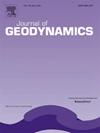U–Pb dating of carbonate gangue with associated As–Sb mineralization in the Matra Fault (Alpine Corsica, France): Constraints for the rifting stage in the Tyrrhenian Sea
IF 2.1
3区 地球科学
Q2 GEOCHEMISTRY & GEOPHYSICS
引用次数: 0
Abstract
This paper presents results of the first attempt to date a normal fault system that affected the eastern side of the Alpine Corsica (France). The U–Pb method was employed to date carbonate material with associated As–Sb mineralization in the Matra Fault, a N–S striking normal fault located southward of the Castagniccia dome. This fault cuts the Alpine nappe stack, here consisting of two oceanic-derived tectonic units, including Middle–Late Jurassic metaophiolites and/or related Early Cretaceous metasediments. From the Late Cretaceous onward, these units were involved in subduction processes and record peak eclogite facies metamorphism. After a complex exhumation path to the surface, these units then experienced long-lasting extensional tectonics linked to the collapse of the Alpine wedge, followed by two rifting stages. The first rifting stage occurred in the Oligocene-Early Miocene and the second in the Middle Miocene to Quaternary that caused the opening of the Liguro–Provencal and the Tyrrhenian back-arc basins, respectively. The U–Pb dating of the Matra Fault yields a weighted age of 9.80 ± 0.37 Ma. Therefore, the Matra Fault developed, in association with syndeformational As–Sb–Fe sulfide mineralization, during the opening of the Tyrrhenian back-arc basin. This finding represents a significant advance in understanding the extensional tectonics in Corsica during the opening of the Tyrrhenian back-arc basin.
法国阿尔卑斯科西嘉山脉Matra断裂带碳酸盐脉石伴生As-Sb矿化U-Pb定年:第勒尼安海裂陷阶段的约束
本文介绍了首次尝试确定影响阿尔卑斯科西嘉(法国)东侧的正常断层系统的日期的结果。采用U-Pb法测定了位于Castagniccia穹顶南侧的正断层Matra断裂中伴生As-Sb矿化的碳酸盐物质的年龄。该断裂切断了阿尔卑斯推覆体,这里由两个海洋衍生的构造单元组成,包括中晚侏罗世变质绿岩和/或相关的早白垩世变质沉积层。晚白垩世以来,这些单元参与了俯冲作用,并记录了榴辉岩相变质高峰。经过复杂的挖掘路径到达地表后,这些单元经历了与阿尔卑斯楔体崩塌有关的长期伸展构造,随后是两个裂谷阶段。第一次裂谷期发生在渐新世—早中新世,第二次裂谷期发生在中中新世—第四纪,分别形成了利古罗—普罗旺斯和第勒尼安弧后盆地。Matra断裂U-Pb定年的加权年龄为9.80 ± 0.37 Ma。因此,在第勒尼期弧后盆地张开期间,Matra断裂发育,并伴有同变形的As-Sb-Fe硫化物成矿作用。这一发现对认识第勒尼安弧后盆地打开时期科西嘉地区的伸展构造具有重要意义。
本文章由计算机程序翻译,如有差异,请以英文原文为准。
求助全文
约1分钟内获得全文
求助全文
来源期刊

Journal of Geodynamics
地学-地球化学与地球物理
CiteScore
4.60
自引率
0.00%
发文量
21
审稿时长
6-12 weeks
期刊介绍:
The Journal of Geodynamics is an international and interdisciplinary forum for the publication of results and discussions of solid earth research in geodetic, geophysical, geological and geochemical geodynamics, with special emphasis on the large scale processes involved.
 求助内容:
求助内容: 应助结果提醒方式:
应助结果提醒方式:


